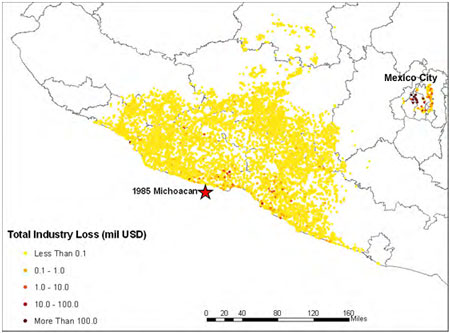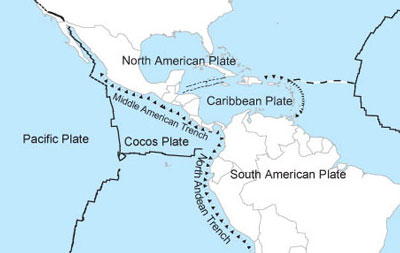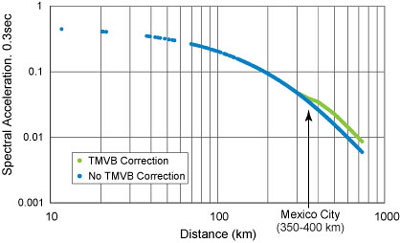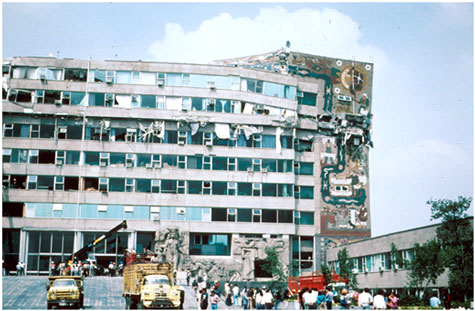
Straight to the Middle: Reflecting on the Michoacán Earthquake’s Impact Twenty-Five Years Later
Sep 22, 2010
Editor's Note: This article is being republished in light of two major recent events. Over 25 years ago, the Michoacán earthquake flattened buildings and killed thousands in Mexico City, hundreds of kilometers from the epicenter. In this article Dr. Tao Lai, Principal Engineer, Dr. Khosrow Shabestari, Senior Scientist, and Vineet Katiyar, Research Engineer, recall the event.
Twenty-five years ago this month, a magnitude 8.1 earthquake struck off the coast of the Mexican state of Michoacán. Although the magnitude was large, the quake's epicenter was sufficiently distant from concentrations of exposure inland that seismologists and engineers would not have expected it to cause significant damage.
But the 1985 Michoacán earthquake was the most serious natural disaster in Mexico's history. It killed 10,000 people and left another 250,000 homeless. Insured losses have been estimated at USD 400 million and total economic damage at roughly USD $4 billion (both estimates in 1985 dollars)1 . Astonishingly, 90% of the total losses were sustained in the capital, Mexico City2—hundreds of kilometers away. More than 800 buildings in the densely populated capital region collapsed, and nearly 3,000 were seriously damaged. Furthermore, the nature of the damage was restricted; while many tall buildings—including the 43-story Latin American Tower and the 50-story PeMex Tower—were virtually untouched, numerous 6- to 15-story buildings suffered severe damage or collapse.
AIR estimates that if the Michoacán earthquake were to recur today, damage to commercial and residential properties from this event would be on the order of USD 16 billion3. Figure 1 shows the loss footprint of a simulation of this event using the AIR Earthquake Model for Mexico. While damage occurs over a wide area the largest losses occur in distant Mexico City. In this article, we'll explore why.

From Cocos to the Capital: Unexpected Amplification
Although not located directly on a fault line, Mexico City is situated east of the highly active Middle America Trench. Here large temblors originate along the boundary between the subducting Cocos plate and the overriding North American plate (Figure 2). Due to certain unique geological features, Mexico City is at heightened risk, particularly from the shallower interface events that occur here.

The Michoacán earthquake was such an event, occurring at a focal depth of just 14 km. The energy it released in the form of seismic waves traversed a great distance—between 350 and 400 kilometers—to reach the capital. But because of the influence of the Trans-Mexican Volcanic Belt, those seismic waves failed to attenuate as might be expected had the event occurred, for example, further north in California or further south off the coast of Chile.
Mexico City is located in the Valley of Mexico, which is in turn located in the Trans-Mexican Volcanic Belt (TMVB)—a range of volcanoes extending west to east across south-central Mexico. The area has no natural drainage outlet for water flowing from the mountains, and soft soils collect in the valley below. Rather than attenuate incoming seismic waves, the low density of material in the TMVB served to slightly amplify the seismic waves of the Michoacán earthquake. Figure 3 clearly shows this amplifying effect.

A City on Sediment
Once the seismic waves reached the Valley of Mexico basin, they encountered a perfect combination of conditions to promote their amplification even further. Indeed, due to the unique conditions both en route to and in Mexico City, the ground motion amplification that took place in the capital on September 19, 1985, was greater by far than the expected median ground-motion estimated by generic attenuation relationships.
Within the Valley of Mexico, Mexico City sits atop what once was Lake Texcoco. The lake was artificially drained in the 1600s and, today, the lakebed soils beneath the capital are made up of silt and volcanic clay deposits fifty to one-hundred feet deep. These deposits resonate with long-period seismic waves and can quite dramatically increase their amplitude. During the Michoacán earthquake, ground motion in the lakebed zone of Mexico City was amplified 8 to 50 times more than the ground motion in the surrounding hills (Singh et al, 1988). Indeed, perhaps in no other location in the world are geological conditions so aligned to yield destruction from distant subduction earthquakes.
Damage to Mid-Rise Buildings
Earthquake-induced building damage is caused by a building's dynamic response to ground motion, which varies depending on characteristics of both the ground motion and the building. One important ground motion characteristic in the context of building damage is frequency, or number of complete cycles of vibration per second. A building responds to frequency content in ground motion by vibrating, and its vibration tends to center around a particular frequency—its natural frequency. Tall buildings have lower natural frequencies and when the ground motion is also dominated by low-frequency (long period) waves, the ground motion and building resonate, leading to greater building displacement and therefore damage. Shorter buildings, by comparison, have higher natural frequencies; for them, high-frequency (short period) seismic waves have the biggest impact. Low-frequency seismic waves can travel great distances, while high-frequency seismic waves tend to attenuate quickly over distance. For that reason, when the seismic waves from the Michoacán earthquake finally reached Mexico City, low- frequency, long-period waves dominated. The frequency of these waves coincided with the natural period of the lakebed soil and thus the waves were amplified. The buildings whose natural frequencies coincided with the frequencies of the waves were mid-rise structures and some high-rise structures (essentially, buildings 6-15 stories tall). Many of these experienced either severe damage or collapse. According to one report, in the hard-hit areas of Mexico City, 34% of buildings taller than five stories experienced some type of structural damage. The mean damage ratio4 of mid-rise reinforced concrete buildings ranged from about 16% (Smolka and Berz, 1989) to 24% (Tiedemann, 1988).
Changes in the Mexico City Building Code
In Mexico, there is no national building code; instead, the more than 2,000 municipios enact their own codes. Still, in the absence of a national code, the Mexico City Building Code (MCBC) is considered to be an important model for the rest of the country and other Mexican states outside the capital have adopted it.
The MCBC was first released in 1942. Revisions were made several times in the decades that followed as damaging earthquakes provided opportunities to identify flaws in existing techniques; the MCBC was replaced in 1957, refined in 1966, and modified again in 1976—the last update before the Michoacán earthquake. At that point, most engineers considered the code to be adequate. They had taken basin amplification into account by assigning very stringent earthquake design provisions for structures with natural frequencies ranging from 0.30 to 1.25 Hertz (Beck and Hall, 1986). So why did so many buildings, even those built or strengthened after earthquakes in 1957 and 1979, suffer collapse?

First, although seismic provisions in Mexico were up to date with contemporary knowledge, their implementation was often compromised by a lack of enforcement. Second, poor workmanship and materials quality was sometimes an issue. Finally, those codes that did exist—though they accounted for amplification did not do so sufficiently; building engineers had not previously considered a scenario in which the incoming seismic waves traveled through the soft soils of the Trans-Mexican Volcanic Belt, thereby amplifying beyond what the basin alone would cause. Fundamentally, building codes prior to 1985 had underestimated the effect of the TMVB, so clearly illustrated in Figure 3.
It should be noted that if such immensely amplified waves had not been produced on September 19, 1985, the MCBC enacted in 1976 would not have been called into question. As it were, however, engineers examined buildings throughout Mexico City after the earthquake. The biggest problems revealed were the lack of confinement in the longitudinal reinforcements of buildings or the improper anchorage of these reinforcements. These flaws made building columns more susceptible to lateral displacement. According to one study, in 65% of cases of major damage, column failure was to blame (Meli, 1989).
To increase the lateral stiffness of buildings, the new Mexico City Building Code—released in 1987—required more stringent provisions regarding reinforcement, including the use of steel braces to stiffen certain structures. Additionally, the allowable lateral displacement of buildings was reduced, particularly for structures located in the lakebed.
Today, it is estimated that the lateral load capacity of buildings built post-1985 is roughly two to three times that of those built prior to the Michoacán earthquake (Meli, 1993). However, much work remains to be done to guarantee enforcement of the new code.
An Earthquake Closer to the Capital: Lowering the Target
It is important to remember that however remarkable was the damage in Mexico City by an earthquake that occurred hundreds of kilometers away, there are other sources of seismicity in Mexico, including crustal faults closer to the capital, and "background seismicity" that captures the potential for earthquakes to occur on as yet undiscovered faults—as was the case for the M 7.1 Christchurch earthquake that struck in New Zealand earlier this month. The impact of even a moderate earthquake striking directly beneath Mexico City (as opposed to at a distance from it) would be significant—and rather different in terms of the types of buildings it would target. Such an earthquake would be rich in both low and high frequency waves—as opposed to just low-frequency waves, as was the case for Michoacán. High-frequency waves would be dominant as they would not have attenuated.
Because high-frequency waves target low-rise structures, particularly those that are poorly built or of informal construction5, low-rise buildings would be at greatest risk from such an event. Such structures make up a greater proportion of building stock in Mexico City than reinforced concrete mid-rise and high-rise structures combined. Therefore, even an earthquake of moderate magnitude nearer in the capital could potentially generate large losses because of the sheer number of structures it would affect.
1 Source: AXCO.
2 Damage also occurred in the states of Colima, Guerrero, Jalisco, and Michoacán.
3 This value is calculated based on AIR's recurrence value for this event: MXN 130 billion (2005 AIR industry exposure database). Trended to 2010 currency, this value is MXN 200.90 billion, or USD 15.83 billion.
4 The ratio of the repair cost of the building to the replacement value.
5 Informal construction implies built without the proper permits and without supervision by a professional engineer. Sixty percent of Mexico City's housing stock was classified as informal construction as of 2000 (Alcocer et al., 2002).
References
Alcocer, S. M., C. Reyes, D. Bitran, O. Zepeda, L. E. Flores, and M. A. Pacheco 2002, "An Assessment of the Seismic Vulnerability of Housing in Mexico," The Seventh National Conference on Earthquake Engineering, July 21-25, 2002, Boston, Massachusetts, USA.
AXCO 2010, Insurance Market Report for Mexico: Earthquake and Other Geological Hazards.
Beck, J. L., and J. F. Hall 1986, "Engineering Features of the Recent Mexican Earthquake," Engineering and Science, January 1986, 2-9.
Meli, R. 1993, "Earthquake Resistant Design and Construction of Reinforced Concrete Buildings, the Practice in Mexico after 1985," Structures Congress 1993, April 19-21, Irvine, California, USA.
Meli, R. 1989, "Seismic Vulnerability and Retrofitting of Buildings: Recent Experiences in Mexico City," Structures Congress 1989, May 1-5, 1989, San Francisco, California, USA. Singh et al, 1988
Singh, S. K., J. Lermo, T. Dominguez, M. Ordaz, J. M. Espinosa, E. Mena, and R. Quaas 1988, "The Mexico Earthquake of September 19, 1985 - A Study of Amplification of Seismic Waves in the Valley of Mexico with Respect to Hill Zone Site," Earthquake Spectra, 4, 653-673.
Smolka, A. and G. Berz, 1989, "The Mexico Earthquake of September 19, 1985— An Analysis of the Insured Loss and Implications for Risk Assessment," Earthquake Spectra, 5, 223-248.
Tiedemann, H. 1988, "Lessons from the Mexican Earthquake of 1985: Quantitative Evaluation of Damage and Damage Parameters," Proceedings of the Ninth World Conference on Earthquake Engineering, August 2-9, 1988, Tokyo-Kyoto, Japan.

